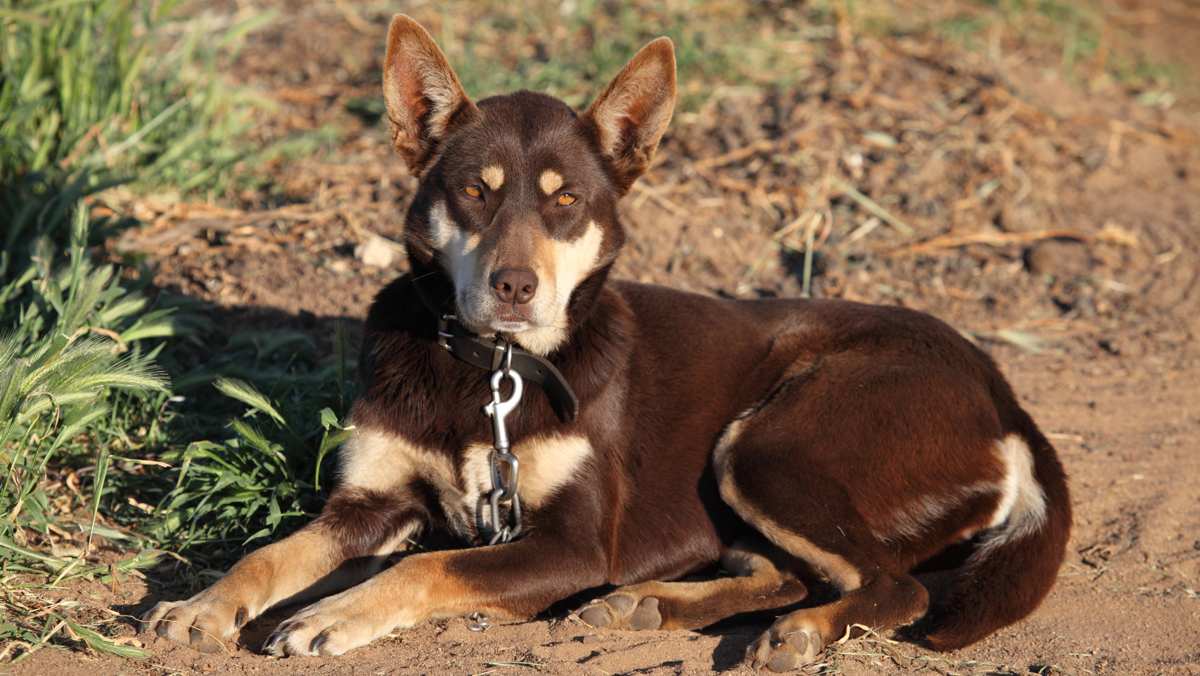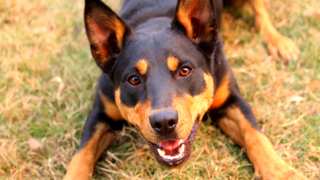Australian Kelpie Dog Breed
Australischer Kelpie
Barb
Barb Dog
Barb Puppy
Kelpie
Pronunciation: Aws-TRAIL-yun KEHL-pee
The Australian Kelpie is a medium-sized, athletic herding dog that originated in Australia. Dogs of this breed are extremely intelligent and task-oriented, and are best suited for working on farms or as active pets. Kelpies require moderate maintenance, respond incredibly well to training, and are very healthy overall. They are not suitable for first-time owners or for apartment living.
Australian Kelpie Breed Details
The Australian Kelpie is a member of the Herding group of dog breeds. These dogs were first developed in Australia in the nineteenth century to herd livestock. (The word "kelpie," though, is of Scottish origin. The first known owner of this breed was a Scottish man; for unknown reasons he named these dogs "Kelpies" after the Kelpie mythology in his native country, which concerns magical water creatures.) Kelpie dogs, meanwhile, are very intelligent animals with exceptionally high work ethics, so they will be best as working dogs on ranches or farms. (They make decent pets only if they're consistently engaged in some form of activity.) This breed is not recommended for first-time owners. Here are a few Australian Kelpie facts for those wondering if this breed is for them:
PROS:
- Extremely intelligent
- Incredibly task-oriented
- Adaptable to numerous situations/environments
- Very easily trained
- Great watchdog ability
- Few known health issues
- Extremely athletic and energetic
CONS:
- Keeping busy is an absolute must
- High exercise requirements
- Sheds moderately to often
- Difficult to obtain
- Frequent socialization with humans/other pets required
- Can turn destructive if bored
- Not suited for apartment life
- Instinctive tendency to chase/nip at moving objects (bicyclists, joggers, children)
- Can be independent and stubborn
Purebred
12 - 15 yrs.
18 - 22 in.
30 - 60 lbs
OverallFamily FriendlyChild FriendlyPet FriendlyStranger Friendly
Easy to GroomEnergy LevelExercise NeedsHealthShedding Amount
Barks / HowlsEasy to TrainGuard DogPlayfulnessWatch Dog
Apartment DogCan be AloneGood for Busy OwnersGood for New OwnersIntelligence
Australian Kelpie Breed Description
These are medium-sized herding dogs that exist in two subtypes: Working Kelpies, which are varied in size and coat types, and Show Kelpies, which have short double coats in solid colors and are generally heavier than their Working counterparts. Some basic Kelpie information: a typical Kelpie is extremely adept at numerous tasks, be it herding, guarding property, or playing active games--and an absolute nuisance when bored. A side note, Animal Planet does a fun "Dogs 101" for the Australian Kelpie that can provide additional information.
- One of its greatest attributes is a Kelpie's intelligence. Through the years, these dogs have been taught to manage livestock herds with little or no supervision, so their ingeniousness and problem-solving skills are at an extremely high level for a canine. It goes without saying, then, that a Kelpie will normally respond very well to any training it receives, regardless of difficulty.
- A Kelpie will be much more at home scampering amongst a herd of sheep than cooped up in an apartment. The way Kelpies herd animals is by running alongside them and nipping at their feet--so new Kelpie owners are surprised when their dogs do the same to children, joggers, even cars! These dogs are much more suited to the open outdoors than inside; the same new Kelpie owner will leave the dog home alone, only to return and find his apartment in shambles.
- Physically, a typical Kelpie is absolutely tireless. While not overly strong, this breed has incredible stamina, and will make a great jogging companion. So naturally, a Kelpie will need a great deal of exercise!
Australian Kelpie Breed History
Australian Kelpie history begins, of course, in Australia--though the Kelpie's origin (and its name) can be traced back to Scotland. In the early nineteenth century, Australian farmers began importing Collies from Scotland and Britain because of the breed's great reputation for herding livestock. As the years passed, the farmers began crossbreeding the Collies with other dogs (and even the occasional Dingo), supposedly to develop a breed that would be able to supervise livestock with little supervision.
This crossbreeding continued for several decades, until in the 1870s a Scottish man named George Robertson sold a black and tan pup named Kelpie to a man named Jack Gleeson--and this is supposedly where the Australian Kelpie breed lineage begins. Accounts vary as to whether Robertson or Gleason named the dog; a "Kelpie" is also the name of a legendary magical water creature that was said to inhabit the lochs in Scotland. In any case, the name stuck, and the original Kelpie dog (later known as "Gleeson's Kelpie") produced offspring known as Kelpie's Pups (or simply Kelpies) that excelled in Australian dog trials in the late nineteenth and early twentieth centuries. By the early 1900s, the Kelpie breed was firmly established across Australia, and as the breed was exported to other nations in Europe and North America during the twentieth century, it became known as the Australian Kelpie.
One of the earliest Kelpies was an all-black dog named Barb (called so after a famous Australian racehorse); hence, all the black dogs of this breed are referred to as Barb Kelpies. Another famous moniker in Australia is Red Cloud Kelpies, which describes dogs that are reddish or brown; supposedly the "red cloud" refers to the dust produced in the arid Western Australian regions.
Australian Kelpie Appearance
The Australian Kelpie is medium-sized, athletic, and streamlined in appearance. Scientists have determined that this breed's genes contain a small percentage of DNA of the Dingo, and this is undoubtedly apparent in a Kelpie's lithe, contoured anatomy.
A typical Kelpie's overall build is compact and muscular, and its body is normally a bit greater in length than in height. The large head is wedge-shaped, the muzzle is quite long, and the jaws are powerful. A Kelpie's eyes are medium-sized and almond-shaped; the eyes are normally brown, though a Kelpie with blue eyes is not uncommon. Kelpie ears are fairly long and erect. The tail is fairly long and curved slightly.
The Kelpie normally has a short- to medium-length double coat, consisting of a dense undercoat and a straight, waterproof outer coat.
The images below represent the coat colors and patterns associated with Australian Kelpies.
Cream
Tan
White
Australian Kelpie Variations
The Australian Kelpie exists in two types:
- Working Kelpies have some variance in size, and are built more for that for which they're named--work. This Kelpie variety can have short- to medium-length, smooth or rough coats, and the coats are usually double-layered. These dogs display a variety of both solid and multiple coat colors as well.
- Show Kelpies are usually shorter and heavier than the Working variety; their muscles normally aren't as defined as Working Kelpies, who spend hours toiling in the fields. This variant typically has a short, smooth coat that exists only in solid colors.
In both variants, a smooth, double-layered coat is most common. The coat can be short or medium in length, and a rough texture is possible; a long-haired Kelpie is quite rare.
The Miniature Kelpie--about 16 inches in height, 30 pounds in weight--does exist, but is rare; it is unclear whether a small/Mini Kelpie is a specific subtype of the breed, or is simply a deviation from normal Kelpie size.
Australian Kelpie Temperament
Intelligent, alert, active, and extremely independent, the typical Australian Kelpie temperament is that of industriousness and enthusiasm. These dogs have been developed to think for themselves while performing tasks, so a Kelpie will undoubtedly have a mind of its own--which is usually a very good thing, because this breed can understand and accomplish quite a lot for a canine. Kelpies are normally fairly standoffish, and are suspicious of nearly anything unknown to them, so plenty of socialization with humans and other pets, starting when the dog is a puppy if possible, is highly recommended.
When it comes to training, typical Kelpie traits and characteristics are virtually unmatched. Dogs of this breed can learn even complex tasks with very few and once the owner sees that the Kelpie understands that task or command it's being taught--move on to another! The Kelpie will remember what it's learned, without a doubt.
The Kelpie personality also makes the breed a fantastic watchdog. Since a Kelpie's instincts make it suspicious of unknown sights and sounds, a Kelpie will undoubtedly bark loudly when confronted with a potential threat.
People considering having Kelpies as pets purely for companionship might want to find another breed. These canines are entirely unsuited to being lapdogs! Kelpies, by instinct, need a job to do, so they will work best as farm dogs; if you insist on having a Kelpie as a pet, make sure to provide plenty of exercise, tasks for the dog to fulfill (like fetching the daily newspaper), and room to run. Because one thing is certain: a bored Kelpie will be a destructive one.
It's best if dogs of this breed have a large outdoor area in which to roam, and it's even better if they have a flock to manage while doing so. Apartments and Kelpies are a terrible match; not only will the dog need plenty of daily outdoor exercise, but it will turn destructive if left alone.
Kelpies shed moderately--but heavily during shedding season. They're not hypoallergenic, so for allergy sufferers, owning a Kelpie is not a good idea.
Australian Kelpies are extremely healthy overall (often living up to 13 years), but may suffer joint and bone issues like hip dysplasia, patellar luxation, and osteoarthritis. A few Kelpies may inherit neurological disorders including Collie eye anomaly, progressive retinal atrophy (PRA), or a rare condition called cerebellar abiotrophy (a nerve condition that affects balance and coordination).
To minimize the possibility of your Kelpie developing these disorders, make sure to obtain your dog from a respectable breeder/owner who will discuss these conditions prior to your bringing the dog home.
Australian Kelpie Health Concerns
Below are potential health concerns associated with Australian Kelpies.
Hip dysplasia
Patellar luxation
Progressive retinal atrophy
Collie eye anomaly
Osteoarthritis
Cerebellar abiotrophy








